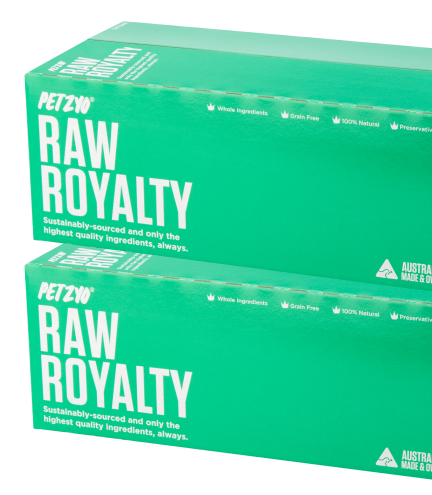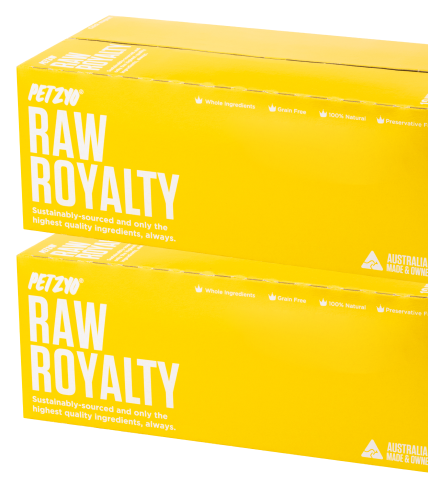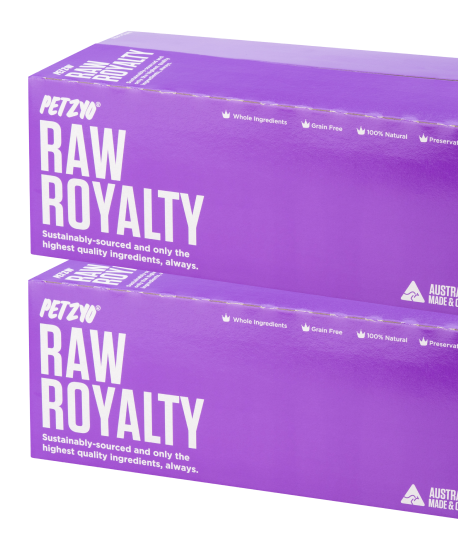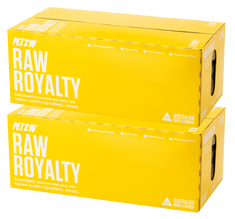
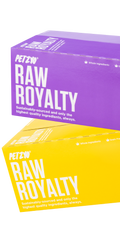
Raw Dog Food (100% Natural BARF Diet)
Looking for the healthiest raw canine food in Australia? Discover our premium raw dog food (100% natural BARF diet) made with human-grade meats like kangaroo, salmon, and chicken, paired with whole vegetables, healthy oils, and nutrient-rich superfoods like flaxseed, turmeric, and chia seeds. Our minimally processed meals provide nutrient-dense, biologically appropriate nutrition for all life stages.
What is a Raw Food Diet for Dogs?
The raw food movement for dogs began in the 1980s, led by Australian veterinarian Dr. Ian Billinghurst. His research linked pet health to diet, leading him to create the Biologically Appropriate Raw Food (BARF) diet, which mimics the natural diet of wild ancestors and includes raw meat, bones, offal, and fruits and vegetables.
Another popular option is the Raw Meat-Based Diet (RMBD), or the Prey-Model, which focuses solely on animal-based ingredients like raw organs, muscles, and bones, excluding grains, fruits, and vegetables.
What's in a Complete and Balanced Raw Dog Food?
A complete and balanced raw diet is more than just a slab of steak or a bone. It’s all about providing your dog with the nutrients they need to thrive. A proper raw diet usually consists of:
- Muscle Meat: This is your main ingredient, providing your dog with high-quality protein.
- Organs: Think liver, kidney, or heart. Organs are nutrient powerhouses, packed with essential vitamins like A, D, E, and K.
- Bones: Raw, edible bones (never cooked!) supply calcium and other minerals while keeping those pearly whites in top shape.
- Vegetables & Fruits: Some dog-friendly veggies (like sweet potatoes or leafy greens) and fruits (think berries!) can boost antioxidants, fibre, and vitamins.
-
Supplements: Fish oil, kelp, or even eggshells may be added to ensure your dog gets a well-rounded diet.
The Biologically Appropriate Raw Food (BARF) method recommends using 70% muscle meat, 10% raw meaty bones, 10% organs (with at least 5% being liver), 10% fruits, vegetables, or dairy (such as kefir, goat's milk, or other suitable dairy sources, but avoid cow's milk products)
Balance is key! Your dog's diet should have the right ratio of meat, bone, and organs to avoid deficiencies or overloading on any one nutrient.
The Benefits of a Raw Food Diet for Dogs
- Shinier Coats and Healthier Skin: A raw diet is rich in Omega-3 fatty acids (think fish or flaxseed), which can help give your dog a glossy coat and reduce skin issues like dryness or itching.
- Stronger Teeth and Fresher Breath: Those raw meaty bones do wonders for keeping plaque away and maintaining healthy gums. Say goodbye to bad breath!
- Better Digestion and Smaller Poops: Yep, you read that right! Raw-fed dogs often digest food more efficiently, leading to less waste—so smaller, firmer poops. (Less clean up for you!)
- Increased Energy Levels: Many dog owners report seeing their pups perk up with increased stamina and energy once they make the switch.
- Weight Management: Since raw food is more natural and less processed, it can help maintain a healthy weight, especially for breeds prone to packing on the pounds.
Find Our Best Raw Dog Food Formula for Your Pet
Every recipe is crafted with the finest Australian meats, using only fresh raw meat, bones, and organ meats, complemented by superfoods like spinach and carrots to provide a complete, balanced diet.
Got Beef - Power-Packed Protein for Active Dogs
High-protein, nutrient-dense beef to support muscle development, stamina, and post-operative recovery. Perfect for high-energy pups and working dogs.
Chick Magnet - Gentle & Nourishing
Lean, easily digestible chicken for dogs with sensitive tummies. Great for puppies, adults, and seniors, offering digestive support and a calming effect for anxious dogs.
Roo’s Clues - Lean & Hypoallergenic
Premium kangaroo meat for dogs with food allergies or weight-conscious dogs. This lean protein supports healthy digestion, overall vitality and is free from grains or fillers.
Shop Petzyo’s Raw Dog Food Today!
Give your dog the diet they were born to thrive on. Real food. Real health. Real happiness. Order your pooch’s nutritious raw dog food filled with fresh ingredients now!
Raw Dog Food FAQs
What is Biologically Appropriate Raw Dog Food (BARF)?
Biologically Appropriate Raw Dog Food (BARF) is a type of raw pet food diet that consists of raw, uncooked meat, bones, organs, fruits, and vegetables, along with supplements to mimic a dog's natural diet.
What is the Best Raw Food to Feed Dogs?
The "best" raw food for dogs is a diet that is nutritionally complete and balanced, safe from harmful bacteria, and made from high-quality ingredients. It should be a mix of high-quality meats (beef, lamb, chicken, fish), organ meats (liver, heart), raw meaty bones, and some fruits and vegetables, prepared safely.
Is BARF Diet Good For Dogs?
Yes, Biologically Appropriate Raw Food (BARF) diets benefit dogs by providing a balanced mix of raw meat, bones, vegetables, seeds, nuts, and fruits, offering comprehensive nutrition. But it may not suit puppies, seniors, or dogs with certain health conditions. Always consult your vet before switching.
What Are the Visible Signs of a Healthy Raw-fed Dog?
Visible signs of a healthy raw-fed dog reflects a shinier coat, higher energy, improved dental health, improved digestion, weight control, fewer allergy-related issues, and noticeable changes in behaviour.
Is It Safe to Feed My Dog Raw Food Every Day?
Yes, it is safe to feed your dog raw food every day, provided the diet is complete and balanced.
Should I Feed Half Kibble and Half Raw?
Yes, mixing kibble and raw food can give your dog balanced nutrition and variety. It’s a cost-effective way to add the benefits of raw ingredients while maintaining convenience. For better digestion, feed kibble and raw at separate meals and choose high-quality, balanced products from trusted brands.
Are There Risks Associated With Raw Feeding?
While raw feeding offers many benefits, it’s important to be aware of potential risks:
- Bacterial contamination (Salmonella, E. coli) can occur if improperly handled
- Nutritional imbalance from incorrect ratios of meat, bone, and organs
- Bone safety: supervise your dog when eating raw bones
- Parasites: source meat responsibly and freeze it to reduce risk
That’s why many dog owners choose pre-made raw products like Petzyo’s, which is carefully formulated by experts to meet nutritional needs and uphold strict food-safety standards.
How Do You Prepare Raw Dog Food?
You can make your own raw dog food to control ingredients and meet your dog’s specific needs, but it’s vital to maintain the right balance of meat, bones, and organs. Handle raw meat safely to avoid bacteria like Salmonella or E. coli. Many owners prefer pre-made raw meals, which are expertly balanced, frozen or freeze-dried, and formulated to meet nutritional and safety standards.
How to Transition Your Dog to a Raw Food Diet?
Switching to a raw diet isn’t an overnight process; your dog's tummy needs time to adjust.
- Start slow: Begin by mixing a small amount of raw food with your dog’s current kibble or cooked diet. Gradually increase the raw portion over a week or two while decreasing the old food.
- Monitor changes: Keep an eye on your dog’s stool, energy levels, and overall demeanour during the transition. Some dogs may have soft stools or a mild upset tummy at first, but that should clear up as their digestive system adjusts.
- Variety: Once your dog is fully on raw food, introduce a variety of proteins over time (think chicken, turkey, beef, and fish) to ensure they’re getting a wide range of nutrients.
